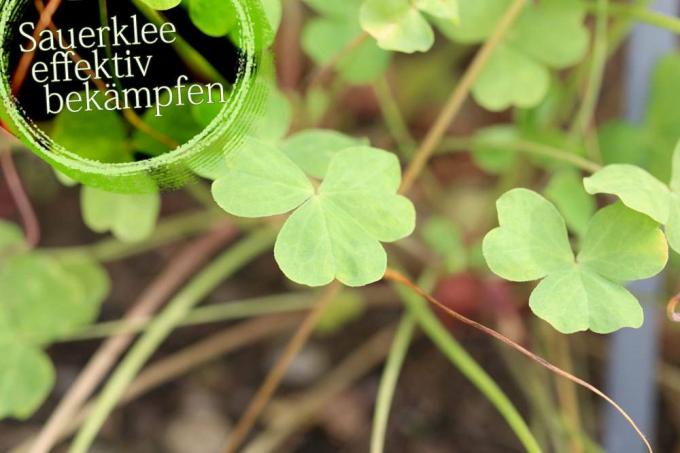
table of contents
- Wood sorrel
- Fight wood sorrel
- In joints
- In the lawn
- mowing
- Limescale
- Fertilize
- Replace the lawn
- Vinegar and pelargonic acid
- Prevent
The horned wood sorrel, which belongs to the botanical genus Oxalis, is a real nuisance in the garden, because the The species that is as robust as it is easy to reproduce prefers to populate garden beds, lawns and Pavement joints. Once established, you won't get rid of Oxalis corniculata any time soon. The weeds thrive almost everywhere and spread over and over again, both through their numerous seeds and deep roots. With these means you can finally fight wood sorrel for good.
Wood sorrel
You can easily recognize the horned wood sorrel by its dark green to red-brown leaves, which are perfectly adapted to strong sunlight due to their dark color. Between June and October the bright yellow flowers appear incessantly, which soon transform into capsule fruits up to two centimeters long. These in turn contain numerous small, brown seeds.
Basically wood sorrel grows on almost any surface, so it is quite undemanding in terms of the composition of the soil and the location. However, the weeds feel most comfortable on soils with these characteristics:
- nutritious
- humus
- slightly acidic to neutral pH
- slightly moist to dry
In the garden, the plant is mainly found in lawns, where it threatens to quickly displace the less robust grasses. But perennial beds, plant pots and stone joints are not immune to settlement either.

Note: Some weeds in the garden can be used in the kitchen and practically "eaten away". Not so with the horned wood sorrel: This contains high proportions of toxic oxalic acid and is therefore not suitable for consumption.
The weeds are extremely stubborn and difficult to destroy, especially since the species reproduces extensively through both root runners and seeds. The narrow capsule fruits jump open at the slightest touch and fling the inside lying seeds several meters away - for this reason the species is also known as "Spring clover". Small animals such as ants do the rest and distribute the seeds in the wider area. More problematic than the seeds, however, are the runners that sprout from the roots that are deeply anchored in the ground. Since these can hardly be removed, especially in loamy soils, the herb will keep coming back if only superficially treated.
Fight wood sorrel
If you want to fight the horned sorrel successfully and finally destroy it, you have to do it as early as possible start: The longer you let the weeds grow rampant in your garden, the harder it will be again Come on. Without physical exertion, you will have lost immediately, because only through regular and thorough weeding will you prevail over time.
In joints
Since Oxalis corniculata keeps sprouting even the smallest pieces of root, this is a common practice Flame overgrown stone joints are only a short-term solution. It is better to remove the weeds from the joints with the help of a joint scraper together with as many root parts as possible and then seal them. Close the gaps between slabs and stones as follows and you won't have any more trouble with stubborn weeds in no time:
- Thoroughly scrape the joints empty
- Fill in new, clean sand
- Sweep the surface and distribute the sand evenly in open areas
- cover stones if necessary
- Spray on grout
- optionally use liquid resin
It is easier, however, not to let the weeds arise in the first place. For this purpose, you should start with the creation of the terrace or the paved path Weed control position under the stones. The horned sorrel cannot penetrate through this, at least with its roots.
In the lawn
The wood sorrel, on the other hand, is much more difficult to combat race. The use of herbicides is forbidden here by itself, after all, the means make no difference between the desired grass and the weeds controlled. Instead, you switch to other methods that are essentially supposed to make life difficult for wood sorrel. Be patient, because the plants cannot be completely removed by weeding them once. Therefore start as early as possible in the year - at best in March or April - to pull out the clover and check the lawn at short, regular intervals for new shoots, which you can also see immediately remove. It is important not to let the plants bloom in the first place.
mowing
After all, what does not bloom cannot develop seeds. mowing For this reason, you should plant your lawn regularly to prevent the horned sorrel from growing. However, since the species grows very shallow on the ground, you should set the lawnmower as low as possible. Between April and October, walk all over the lawn about twice a week and keep it continuously as short as possible. Frequent cutting of the above-ground parts of the plant weakens the weeds in the long term, so that they gradually recede.
Limescale
Regular liming of the lawn can also help against horned sorrel - but it doesn't have to. After all, the weeds thrive well on slightly chalky subsoil and cannot be driven away with mere liming. Nevertheless, this measure is to be rated positively, because it strengthens the growth and the defenses of the grasses - and Oxalis finds fewer opportunities for unhindered spread.
tip: However, do not just start liming, but first of all use a soil analysis to check whether there is any need at all. Contrary to some claims, the horned sorrel is by no means a pointer plant for soil that is too acidic.
Fertilize
The right one often works better than liming the lawn fertilization Against wood sorrel: Since the weeds prefer to grow on nutrient-poor substrates and only a small one If there is a need for nitrogen, you can prevent it from spreading or even with regular lawn fertilization destroy. Horn meal, which is a purely organic fertilizer, is perfect for this purpose. Horn meal only adds nitrogen to the soil, but decomposes only very slowly and thus counteracts over-fertilization.
tip: Be careful with fertilizers with a high phosphate content. The horned sorrel needs above all phosphorus for its growth and reacts happily to an appropriate supply.
Replace the lawn
A massive spread of wood sorrel on the lawn can only be combated sustainably with one measure. Get rid of the weeds with a thorough renewal of the entire lawn. The best way to do this is as follows:
- Fertilize the lawn vigorously
- Let grow for 14 days, do not mow
- then cut as deep as possible
- Scarify the area
- Remove areas densely overgrown with horned sorrel
- Apply fresh topsoil
- Re-sow the lawn
- Water the area thoroughly
Only partially heavy weeds can be removed in the same way, only that in this case you do not have to treat the entire lawn area. Remove the wood sorrel with the help of a digging fork. Remove the top layers of soil (and remove any root residue) and sow or sow new lawns. cover the bare spots with turf.
Vinegar and pelargonic acid
Instead of poisonous herbicides, you can also combat wood sorrel vegetation by spraying leaves that appear between stone joints with undiluted vinegar. However, the treatment only has a superficial effect and the plants keep sprouting out of the roots. On the other hand, vinegar is not suitable for lawns, as the agent also attacks the grasses. The natural fatty acid pelargonic acid, on the other hand, is completely unsuitable for weed control, as it only degrades very slowly and also easily gets into bodies of water.
Prevent
Prevent horned sorrel invasion with careful and regular lawn care: mowing, Scarifying, Lime, fertilizer and watering during the summer months help that the green space remains healthy and that only the grasses you want grow in it. In addition, before any planting within the lawn area, you should carefully check newly purchased container plants for any oxalis and others Weeds examine and remove them if necessary. Weeds are often brought in from the outside, but you can avoid this with appropriate control.





